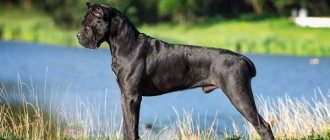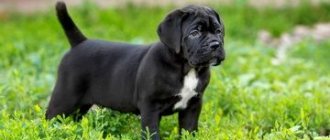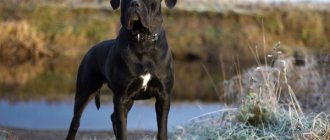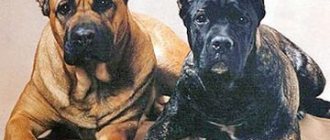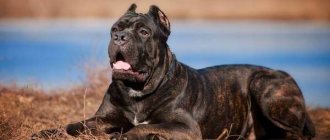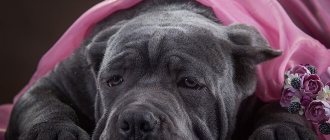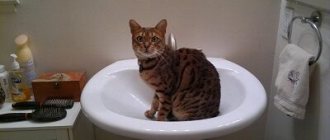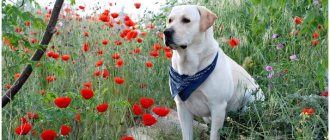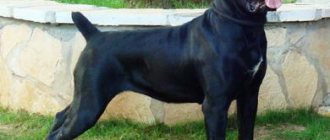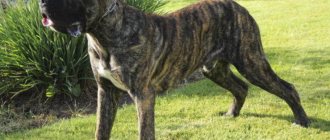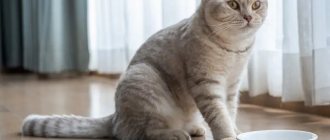The Cane Corso breed has been gaining popularity in recent years.
The dog has many advantages, it gets along well in families with children, and can become a good friend to a lonely person, but the main purpose of the breed is to protect the territory.
Cane Corsos are distinguished by their attractive appearance.
They are powerful, muscular, moderately fit, and have shiny, silky fur.
But for your dog to live with you as long as possible, it needs proper care.
Story
The appearance of the breed occurs in Medieval Italy. These fearless dogs hunted wild animals, herded livestock, and were devoted guards.
But at the beginning of the 20th century, the number of these animals turned out to be minimal due to the aristocrats stopping keeping massive pets at court. Gradually, the individuals lost their purebredness - mixing of blood occurred.
In the second half of the 20th century, the history of origin took a new turn - breeders began to revive the breed and their efforts were crowned with success. In 1994, the pets received official recognition from the Italians, and then on the international stage. This allowed the roots of the corsa to be preserved.
Video
You can learn more about the characteristics of the breed and its content from the video. The video was filmed by the “All about cats and dogs” channel.
Was this article helpful?
Thank you for your opinion!
The article was useful. Please share the information with your friends.
Yes (100.00%)
No
X
Please write what is wrong and leave recommendations on the article
Cancel reply
Rate the benefit of the article: Rate the author ( 1 vote(s), average: 5.00 out of 5)
Discuss the article:
Description
During selection, breeders used purebred individuals. These dogs are muscular, confident dogs. They have an attentive gaze, interesting facial expressions, and strong bones, which makes the pet look angry and aggressive.
The animal has an athletic build:
- straight strong back;
- powerful legs, shoulders;
- the docked tail is compacted at the base;
- massive head, upturned muzzle, uniform and elastic skull;
- the forehead in front is slightly convex, and the occipital part is flattened;
- the nose is black, the nostrils are large;
- moderately sagging lips, tightly closing jaws;
- large teeth;
- the iris has a black tint (occasionally there are specimens with blue eyes);
- hanging ears of a triangular shape (they can be cropped);
- dense skin, hard shiny coat.
From the description of the breed it is clear that this is an elegant dog with powerful muscles. Fans of the animal especially highlight its endurance, tireless efficiency, and protective qualities.
Historical reference
The Cane Corso dog breed is undeniably the heir to the ancient Molossians, to be more precise, the ancient Tibetan Great Danes. Modern Tibetan Mastiffs (Mastiffs) are a breed that has experienced “reincarnation” more than once, but their appearance even today makes people shiver with goosebumps. The first Tibetan Dogo appeared on the Eurasian mainland 1000 years BC, or so the story goes. An aggressive giant trained to catch people was presented as a gift to the ruler of China. Having spread throughout Europe and Asia, Molossians became the ancestors of many modern breeds.
New breeds of dogs have been developed over the centuries to suit the needs of specific territories. The descendants of the Molossians who came to the Roman Empire were also used for their intended purpose - arena battles, military campaigns, and territory protection. Mentions of giants called Corso are found in hunting and baiting chronicles dating back to 1400–1500. It should be noted that in some territories, four-legged animals were used as flock guards. Chroniclers characterize the ancient Cane Corsos as strong, tireless, fearless and loyal dogs.
It is ethical to count the official history of the breed from the times of the prosperity of the Roman Empire. It is this time period that is replete with historical monuments depicting the early Cane Corso in hunting, arenas and fighting. The development of these powerful dogs is continuously intertwined with the history of Italy. Even without delving into cynology references, historical sources tell of giant dogs dressed in armor and lined up in ranks. About dog fights and fights with wild animals. About evil four-legged slave overseers and palace guards.
The Roman Empire fell shortly before the fifth hundred years of our era and a feudal system reigned in Italy. This stage should be considered as a separate step in the formation of the breed. The export of dogs atypical for Italy, for example, Celtic Greyhounds, led to changes and the creation of new progenitors of the breed. Against the backdrop of changes, the already established Italian Cane Corso was widespread throughout the country, especially in the South, where hunting for large wild animals flourished.
With the new regime, dogs began to be used in a new position - guarding farms in the off-season. After the harvest, the land was left under the responsibility of one person and several Cane Corsos. It should be noted that the breed was used for quite a long time as a cattle driver, which also limited contact with the outside world. The echoes of such “professions” were unshakable loyalty to one person - the owner.
The versatile use of Molossians has led to the versatility of modern Cane Corsos. In addition, such powerful dogs were highly valued, which led to a global expansion of the high-quality gene pool. However, history cannot be a straight line; there are always peaks and valleys. The downfall of the breed was the Second World War, the general crisis and the collapse of the economies of many countries. Lack of food and the extermination of “non-front” dogs brought the Cane Corso to the point of extinction and the end of these giants was too close to prevent it.
The revival of the ancient giants is an example of the titanic loyalty and perseverance of one man - Mr. Giovanni Bonatti Nizzoli. Being an educated person, versed in history and facts, the man believed in a miracle and raised the wave of the revival of the Cane Corso. 10 years after the idea was conceived, in 1983, a group of researchers (who were also the founders of the Cane Corso lovers club) literally combed the southern regions of Italy in search of surviving representatives of the breed. By 1987, the first official breed standard was drawn up. The description not only revealed in detail every feature of the ancient giants, but also clearly indicated the differences between the Cane Corso and Mastiffs and Neapolitan Mastiffs in particular.
Before the official opening of breeding registration (1994), more than 500 producers and 700 puppies received positive expert assessment and recognition. Immediately after the recognition of the breed by the Italian Canine Society, the number of dogs exceeded the three thousandth threshold. In 1996, the best producer of Italy with honor defended the reputation of the Cane Corso at the FCI (International Cynological Association) exhibition.
Varieties
The descendants of the Corso Como have a peculiarity - a varied appearance. The animals contain features of a Great Dane, Mastiff, Bullmastiff, and Boxer.
Carso types:
- Likeness of a Great Dane: Tall, slender, narrow-chested, calm, moderately touchy and devoted to his owner.
- Resembling a Bullmastiff: Active, stubborn, with a muscular chest and back.
- Almost Mastiff: Phlegmatic, lazy dog, but is a good guard and can easily tolerate heat.
- Boxer type: The body has a square shape. An energetic, cheerful pet.
- Similar to the Staffordshire Terrier: Muscular back, limbs, chest. The animal is strong and resilient. But these dogs behave aggressively towards other brothers.
How long do purebred animals live?
According to veterinary experts, there is a clear relationship between the breed and the years measured to the animal. It has been scientifically proven that the smaller the dog, the longer its life.
The vitality of representatives of different breeds varies. This is due to human breeding activities. When developing standards, dogs develop and reinforce features that are often unnatural.
Breeding a breed is fraught with complications, which are expressed in hereditary diseases:
- Chihuahua. These cute little creatures are genetically prone to medial dislocations of the kneecaps, elbow joints, and various dysplasias.
- Dachshund. Natural hunters, with a funny long body on short legs, pay with health for such a body structure. Hereditary pathology in dachshunds is intervertebral disc disease.
- Shar-Pei. Not only in this breed of dog, but in all pets with skin folds, the disease entropion, which is essentially an entropion of the eyelid, is common.
- Rottweilers. Strong, brave, fearless, smart. But they are also susceptible to hereditary diseases - aortic stenosis, Rottweiler leukoencephalopathy, follicular lipidosis.
- Pikines. This ancient breed is distinguished by a special eye structure, for which it suffers from a tendency to eversion of the eyelids, cataracts, and corneal ulcers.
Each breed has its own Achilles heel - dogs with flat faces have problems with the respiratory system, with skin without fur - they suffer from allergies, large pets are often diagnosed with diseases of the joints and bones.
Breeders allow for different situations that affect the life expectancy of dogs:
Inbreeding; Exclusion of the factor of natural selection; The appearance of the offspring becomes a priority, not health; The lifespan of the progenitors of the offspring is not taken into account.
Dogs of breeds that are less susceptible to selection changes, of medium size, without any special appearance, live the longest. These are terriers, shepherds, huskies.
The presence of long-livers in the family is of great importance. If the pet's parents lived to a ripe old age, then it has every chance of a long life. If we talk about numbers, on average, dogs live about 12 years.
Characteristics
Corso representatives are large in size. An adult dog has the following parameters:
| Male | Bitch | |
| Height at withers/cm. | 62-70 | 58-66 |
| Weight, kg. | 45-50 | 40-45 |
You can understand your pet’s compliance with breed standards by the development indicator by month:
| Age/month | Bitches | Males | ||
| Height/cm | Weight/kg | Height/cm | Weight, kg | |
| 3 | 42 | 12,5 | 49 | 13,5 |
| 4 | 47 | 16,5 | 56 | 18 |
| 5 | 55 | 22,5 | 62 | 24,5 |
| 6 | 57 | 28 | 64 | 31,5 |
| 7 | 58 | 33,5 | 65 | 37,5 |
| 8 | 59 | 36 | 65,5 | 40 |
| 9 | 59,5 | 38 | 66 | 42 |
| 10 | 60 | 40 | 66 | 44 |
| 11 | 61 | 41,5 | 67 | 45,5 |
| 12 | 63 | 43 | 67 | 47,5 |
| 24 | 64 | 45 | 68 | 50 |
This is an average characteristic to guide the owner while the dog is growing. These weight and height tables allow you to track the development of your pet at any age.
Breed information
This breed has been known since the Roman Empire. At that time, these dogs were used for battles in the arena and for guarding palace grounds.
At the beginning of the last century, the dog was undeservedly forgotten, but now it is again popular and in demand..
It is customary for Cane Corso dogs to have their tails and ears cropped, despite the fact that in many European countries this procedure is prohibited by law.
The dog has prominent muscles and a powerful chest. Representatives of this breed have a wide head and large paws. The length of the body is slightly greater than the height of the dog at the withers.
The coat color
can be different - gray (both light and dark), black , brindle and red .
As adults, dogs can grow up to 70 cm, with an average weight of 45 to 59 kg. Bitches are always smaller in size than males.
Read more about Cane Corso sizes and standards here.
Character and appearance
Individuals of the Cane Corse breed are calm, loyal, and intuitive. Instincts allow the pet to quickly make a decision - if necessary, to defend the owner in case of danger. As long as he lives in a family, he protects the peace of the owners.
Sometimes these animals are stubborn, but their predisposition to dominate over the owner is less pronounced.
The purebred Corso is characterized by the following traits:
- Loyalty – it is difficult to feel separation from the owner.
- Kindness – treats children with care.
- Accommodation with pets in the family.
- Love of active games outside, running, long walks.
- Barks only when there is danger.
- Does not show unmotivated aggression.
- Able to control power.
Canicors is an excellent guard. It is not for nothing that this breed is also called the Italian watchdog. If the guest is friendly with the owners, the pet will remain calm, but ready to attack. In an unfriendly relationship, the dog immediately shows that he is in control, but will take active action only after the owner’s command or when aggression occurs.
The innate instinct to protect the weak contributes to the fact that the pet takes care of children with special zeal.
Although the pet has a formidable appearance, purebred dogs are not able to live without an emotional connection. They strive to gain the owner's approval, and changing ownership is considered a serious challenge.
According to the standard, the color of the breed should be the following colors:
- grey;
- chocolate;
- black;
- brown;
- brindle;
- ginger;
- pale yellow.
Rare ones include:
- murugi color - a variety of dark brown, the tips are black;
- Formentino color is red, endowed with a gray or blue mask.
The presence of white spots on the fingertips, chest, and nose is allowed. There are known types of tan with a black-tiger coat color.
How to choose?
When choosing a future pet of this breed, you should follow the rules for choosing any purebred dog.
For this:
Although no one forbids the future owner to choose a dog without documents, it should be remembered that only the metric about the origin of the puppy is a confirmation of its breed. Many people choose a dog based on its color, trying to choose one that is more valuable or rarer
In principle, this approach to choosing a dog is acceptable, but in addition to color, you should also pay attention to other exterior features of the puppy, in particular, its physique and proportionality. Since the character of the dog is also specified in the requirements of the standard, it is necessary that it be typical of a real Corso
Therefore, it is best to choose a brave, but not aggressive baby, who is calm, friendly and moderately curious. The puppy's health is also of great importance.
Not to mention the fact that a dog’s illness greatly complicates the life of both the pet and its owner, it can also negatively affect the appearance. Therefore, it is advisable to avoid lines where there are dogs with dysplasia or, for example, allergies.
When choosing a purebred Corso puppy, you should focus on how well the chosen baby meets the breed standard, especially with regard to color, build and bite.
So, for example, speaking about color, we can recommend choosing an animal with a coat shade that will be considered standard even if it changes after the puppy grows up.
Naturally, it is not recommended to take dogs of non-standard colors if you plan to exhibit your pet at exhibitions or participate in breeding in the future.
Education and training
When training a Cane Corso puppy, it is important to teach the pet to recognize the owner as the leader - then he will obey unquestioningly. Classes with animals are based on games, without rudeness or punishment, but it is important for the owner to be persistent.
The puppy should undergo a general training course, and after 9 months, learn the “City Dog” program for socialization. Classes should be entrusted to an instructor who has positive recommendations. If you make every effort during training, your pet will grow up obedient.
When raising an animal, it is important to follow the advice of experienced owners and start training from the first day the pet appears in the house.
First, the puppy is toilet trained, then to the main commands, trained before feeding, praised, and given a treat.
Dog First Aid Kit
Finally, we will give some recommendations about “first aid” for your Cane Corso. Any good owner who loves and takes care of his dog should have medical supplies at the ready. To quickly bandage the paw and eliminate colic in the stomach.
Iodine, brilliant green, bandages, cotton wool, hydrogen peroxide, boric acid, and activated carbon are always welcome in a dog's first aid kit. Vishnevsky ointment is also indispensable - it quickly relieves inflammation. For pain relief and at high temperatures, the dog will need analgin.
Be sure to keep ear and eye drops on hand to treat infections. They must be special, veterinary. Among the tools, put in your first aid kit a pipette, nail clippers, a thermometer, an enema, tweezers and a couple of syringes.
Remember that even a small cut on a dog’s paw needs to be treated, and not think that it will go away on its own. And of course, give your Cane Corso maximum attention and care. It even treats animals, sometimes no worse than medicine.
Surrounded by love, your Cane Corso will undoubtedly live a long, fulfilling life!
Did you like the article? Show it off by liking it. If you have any questions, ask them in the comments or tell your story about the Cane Corso.
Care and maintenance
The dog feels good at home, in an enclosure. But since she is a freedom-loving person, it is unacceptable to put her on a chain. The best option for the animal would be to live outside the city, in a fenced area. In winter, you cannot keep your pet outside, since the fine undercoat does not protect against frost.
Care and maintenance in the apartment:
- Massage, use of shampoos, and regular brushing will help preserve the beauty of the coat. For these purposes, medium-hard brushes are used. After cleaning the pet, comb it with a fine-toothed comb according to the hair growth.
- Wax and dirt are regularly removed from the ears using a cotton-gauze swab.
- Discharge from the eyes is carefully wiped with a clean cloth moistened with a solution of chamomile flowers or boiled water.
- Tartar is removed in a veterinary clinic.
- Bathe the animal using zoo shampoo.
- Regularly inspect the paw pads for wounds. Claws are trimmed in a timely manner.
- The apartment will provide your pet with a spacious place (bed, changeable sheets).
- Walk with the animal 2-3 times a day for 1-2 hours.
- They buy special bones for the dog for brushing teeth and playing.
The first mating should be done when the dog reaches the age of 2 years. Early birth will negatively affect the health of the bitch.
How to determine age?
To do this, experts recommend paying attention to external signs that, with a greater or lesser degree of accuracy, will indicate how old the pet is approximately.
Teeth
- In Welsh Corgis aged 1-2 years, the edges of the teeth are pointed and have trefoil-shaped protrusions. The color of the teeth is white, and they themselves are smooth and shiny.
- At the age of two, the cusps on the teeth begin to wear off, but they themselves are still snow-white.
- By the age of four, the tubercles on the teeth are almost completely erased, and their color becomes duller and not white, but grayish.
- Starting at the age of 5, the teeth gradually begin to turn yellow and the edges of the fangs become dull.
- At 6-8 years old, the canines are completely blunted, and the incisors begin to take on a concave shape. In addition, hardened plaque called tartar may also appear on the teeth.
- At 8-10 years old, the Welsh Corgi's teeth completely turn yellow or acquire a brownish tint. The fangs, already fairly worn out and dull, are shortened, and the hooks take on an oval shape.
- At the age of 12 or more, teeth become loose and may even fall out; at this time, the dog’s bite often deteriorates due to the loss of part of the teeth.
It should be remembered that although this method is considered the most accurate when determining the age of a Welsh Corgi, even it can give an error of up to a year, or even two.
After all, the degree of tooth wear depends not only on age, but also on what food the dog eats, as well as on heredity and the initial strength of the enamel.
The absence of some teeth may also be due not to age, but, for example, due to their loss in the event of injury.
Wool
Young Welsh Corgis have a shiny and quite soft coat. It coarsens with age and can become more brittle and dull. In older animals, the fur is uneven in structure, may look somewhat patchy and become dirty more quickly.
The first gray hair on the face usually appears at the age of six; after the age of eight, it can move to the animal’s forehead.
However, some individuals turn gray earlier: the first gray hairs appear on them already at the age of three, which is often associated with the individual characteristics of the dog or with metabolic disorders.
Eyes
Young Welsh Corgis have clean and clear eyes, as if they sparkle with joy and health.
Older dogs' eyes become dull and may become sunken, and older Corgis may develop cataracts or glaucoma.
Puppies and young corgis are active, active and playful
Muscle tone
Young dogs have elastic and strong muscles, but as they age they become more flabby. In addition, if a Welsh Corgi does not exercise much in old age, it may become obese.
Nutrition
In order for your pet to feel physically good, it is necessary to follow a nutritious diet. The amount of food intake, as well as the portion of food, depends on the age of the pet. Owners choose the following types of dog food:
- Dry. A product that is safe for health is expensive, but the owner is freed from regularly preparing a menu for the animal. The finished product contains vitamins, nutrients, and microelements. An experienced veterinarian will help you choose the right dryer. If required, the doctor will recommend additional medications.
- Natural. This is an inexpensive option compared to dry food. The main advantage of healthy food is that the owner knows what the dog is eating. Optimal nutrition: cereals, vegetables, meat (low-fat varieties are used), milk, fish.
During pregnancy, the bitch's diet is changed 14 days before giving birth. It is allowed to purchase vitamins or special food. For the first 7 weeks, the dog eats according to its usual diet, and then the daily portions are gradually increased (attention is paid to cereal products).
Health and treatment
The breed's problems include a predisposition to specific diseases, so you need to carefully monitor your pet's health. Dangerous pet pathologies are considered:
- dysplasia;
- plague;
- epilepsy;
- entropion;
- hemophilia;
- allergy;
- rabies;
- thyroid diseases;
- umbilical hernia;
- bloating.
The health of the Cane Corso is influenced by heredity, as well as the care of the owners. Vaccination administered up to a year will help strengthen immunity. Further vaccinations are given every 12 months throughout the animal's life.
The pet must be regularly examined by an experienced doctor - during the medical examination, the doctor will explain how you can notice signs of disease, provide assistance if the condition worsens, and improve the functioning of internal organs.
Causes of premature death of a dog
Accidents, poisoning, and existing pathologies of internal organs lead to the sudden death of animals. Negative consequences are difficult to predict, however, it is preferable to know what potential dangers threaten your pet.
Common causes of premature canine death:
- poisoning;
- heart disease;
- pneumothorax;
- tracheal collapse;
- congenital abnormalities;
- expansion, volvulus of the stomach;
- ulcer;
- splenic tumor rupture;
- foreign body entering the throat;
- heatstroke;
- injury.
Dogs often suffer from poisons intended for rodents, poisons distributed to exterminate stray dogs. During a walk, be sure to keep an eye on your pet; if the dog does not respond to the command “ugh,” put on a closed muzzle so that the dog does not try questionable “food.”
Heart diseases can manifest asymptomatically, but if a young dog gets tired quickly, is weak, or is breathing heavily, you need to visit a veterinarian for a diagnostic examination.
Air accumulation in the peripulmonary space (pneumothorax) occurs due to injuries to the sternum leading to damage to the emphysematous bladder or existing tumor on the lung.
Tracheal collapse is more common in small breeds, is expressed by a sharp cough after active mobility or the manifestation of strong emotions, and sometimes occurs as a complication of past infections.
A congenital pathology that leads to tragic consequences is the displacement of the cervical vertebrae as a result of insufficient development or defect of the ligaments. An accidental jolt to the problem area can cause pressure on the spinal cord and be fatal.
Gastric dilatation and volvulus are more common in older dogs; both pathologies interfere with the normal blood supply to other organs and are considered deadly. Prevention of stomach problems is considered to be proper nutrition, adherence to a feeding regime and moderate exercise.
The premature death of the animal is caused by complications of peptic ulcer disease, expressed in the formation of a through hole in the wall of the stomach or bleeding. A precaution is the proper nutrition of your pet.
New growths on the spleen (benign and malignant) are susceptible to rupture, which can lead to fatal loss of blood. Tumor rupture is possible even with minor damage caused by difficult bowel movements or increased physical activity.
https://dog-care.ru/zdorove/voprosy/skolko-zhivut-kane-korso.html
Swallowing a foreign object risks suffocation or injury to internal organs as the swallowed object moves inside.
Heatstroke is caused by severe overheating of the body and often occurs in dogs locked in a car in hot weather.
A dog can be injured on the street (being hit by a car, fighting with other dogs, etc.), at home (falling from a height, electric shock, etc.), the danger of injury depends on the degree of its severity and the provision of first aid.
Advantages and disadvantages
If you look at the positive and negative aspects of the Cane Corso Italiano, then a lot depends on the methods of raising the pet, its character, and lifestyle.
| Advantages | Flaws |
| Ease of training | Requires a lot of space |
| Loyalty to the owner | Need active, active games |
| Safety for children | Out of boredom, your pet chews furniture or shoes |
| Ability to control powers | The dog is not suitable for sedentary people |
| Guard qualities without special lessons | Corso does not like to be alone and eats a lot |
| Obedience | Small animals are considered prey for the canoe (unless they live together) |
An affectionate, kind dog, he is attentive to his owner and demands the same attitude towards himself.
What qualities will dominate in a pet depends on the owner, because it is he who chooses the training method.
Place for an aviary with a booth
To decide on the location of the installation of the booth with an aviary, it is necessary to meet a number of requirements, namely:
- The ideal option is to have a small dry hill on the plot;
- Installing an enclosure with a booth in such a place will allow the dog to observe the house and its surroundings;
- The orientation of the dog house relative to the leeward and sunny side of the garden plot.
Today you can buy a ready-made doghouse for a Cane Corso in a specialized store, but building it yourself is cheaper and easier.
On the Internet you can find a lot of drawings and a variety of designs for a comfortable dog house. We are sure that your pet will appreciate such care. If you want to buy a kennel for a Cane Corso, then you need to familiarize yourself with the wide selection of kennels on the website of a large company specializing in the sale of high-quality and reliable dog houses at reasonable prices.
Most children want to have pets. Some are a dog, some are a cat, some are a mouse. So I was a lover of living creatures. There were birds and cats. When I grew up a little (up to 10 years old) I wanted a dog. This was the end of the 80s. I remember many kids had dogs in their yard, some had German shepherds, some had Airedale terriers (hello to the movie “The Adventures of Electronics.” I wanted to too, but my mother didn’t allow animals to come home, my father was a little passive in this matter, but my sister was not at a loss and brought... a lapdog! It was a shock for me. On the one hand, a dog, on the other hand, it’s a shame to go out into the yard. So I lived with a feeling of inferiority from the fact that I didn’t have a normal dog until I came of age. And so in 1999 I got married, that’s it... I am my own boss, and of course the first thing I did was bring home an American Staffordshire Terrier puppy. I was deeply disappointed. My wife developed a terrible allergy. There was nothing left to do but return the puppy to the breeders with an explanation of the reason for the return. The breeder turned out to be decent, stepped into the situation, took it puppy. I can say that I have come to terms with the fact that I won’t have a dog, and if I do, it will only be when I build a house and he will live on the street. 18 years have passed. Over these years, I never stopped wanting a dog, studied breeds, etc. .P. About 8 years ago I read about the Italian Cane Corso breed.
List of suitable nicknames
When coming up with a name for a pet, it is important that it is short (easily pronounced by the owner). Popular for Cane Corso are:
| Boy | Girl |
| Archie | Aina |
| Argon | Molly |
| Bonya | Betty |
| Vinci | Sally |
| Hector | Nancy |
| Django | Ghersi |
| Prince | Irma |
| Tyson | Alice |
| Osman | Barça |
| Theo | Stacy |
| Norman | Sheldy |
| Khaki | Chloe |
In order for an animal to remember its name, it must be mentioned in positive cases, and avoided when punished.
Rules for choosing puppies
It is difficult to purchase a purebred Cane Corse. You should enlist the help of an experienced dog handler.
When contacting breeders, you should pay attention to such nuances as:
- Availability of official documents with the results of checks for the absence of ongoing dysplasia in the baby’s parents.
- Was testing carried out to identify the dog’s unbalanced mental state, with a corresponding note in the certificate?
- Do the parents have a breeding assessment of the exhibition not lower than “very good”.
Puppies must be branded, ears and tail docked, and vaccinated. Healthy babies grow up calm, have an appetite, a strong psyche, and courage.
It is better to buy a pet after 5 months, when the teeth have changed, the bite has become clear, and the eye color has normalized.
When old age comes
As already mentioned, maturity for the Corso comes after 6 years. An aging dog begins to gradually lose ground, is less active, and its appetite may worsen. Many Corso owners note that as they approach advanced age, these dogs become more impressive, wise and noble. They phlegmatically observe those around them and in most cases remain absolutely calm.
In addition to changes in behavior, changes can also be observed in the physical condition of dogs. They appear in:
- gait disturbance;
- slow reactions;
- loss of balance;
- impaired concentration;
- heart problems;
- prostatitis ICD.
In addition to acquired diseases and congenital pathologies, with age the Corso may begin to be bothered by all previously received injuries - dislocations, fractures, sprains. If received in adulthood, they heal worse and cause more inconvenience.
Reviews
Svetlana: “This is my second dog - I’m glad I chose this breed. We live outside the city, so we have no problems with daily walks. She accompanies me everywhere in the yard - she doesn’t like to be alone.”
Nikolay: “I started training Cane Corso when I was 4 months old. Now it is an obedient animal, devoted to family members. There were, of course, problems with training. Zheton only wanted to play and run, but I was still able to raise him into an obedient male.”
Natalya: “A large dog causes problems when living in a city apartment. When walking you have to be alert - your pet does not ignore cats and birds. He eats everything, but it’s much easier to drive him away from the table than a Labrador.”
Eight months to a year
Like humans, puberty in dogs is a time of protest, disobedience, and self-display.
Now the puppy may refuse to follow commands, rebel against your demands, and sometimes growl. Sometimes the dog begins to be jealous of the chosen family member towards others, including children. During walks, he “goes crazy” and runs completely different from where you are leading him.
Surprisingly, at the same time he is very shy and sensitive. Sometimes it seems that he has become a two-month-old baby again, who has never seen other dogs or strangers in his life.
The owner will have a difficult time during this period, since he needs to find a balance between the rigidity necessary to suppress aggressive behavior and kindness so that the teenage Corso does not feel rejected. In a word, everything about him is like a person’s.
At 8 months, males should weigh 38-40 kg, females - 34-36 kg. By the year the weight will increase: 44-46 kg and 38-43 kg, respectively.
After a year, up to 3-4 years, the personality of the Cane Corso still continues to develop, as does the body. Some character traits may change, and if you give a male dog for mating, after that he, feeling like a macho, will again try to push the owner off his “pedestal”. As always, you need to be firm, but loving and patient. By the age of two, males weigh, according to the standard, 48-55 kg, females - 38-45 kg.
Photo and video review
The appearance of the animal in the picture evokes genuine admiration. As a child, these are fluffy little balls that you want to cuddle and take with you. As they grow older, mini corsos acquire a powerful, intimidating appearance.
